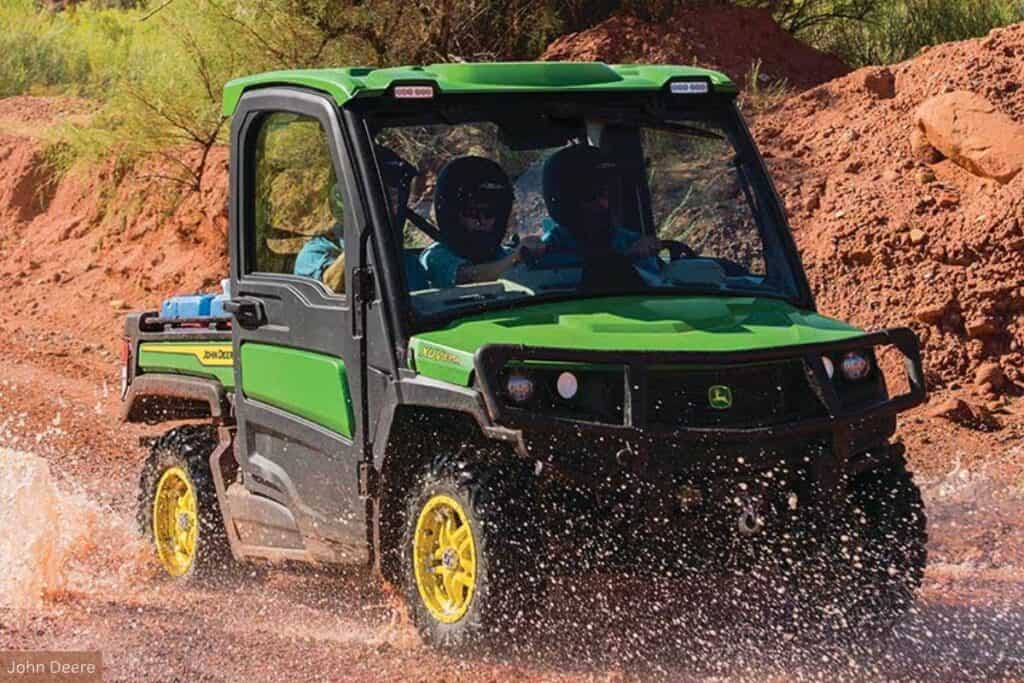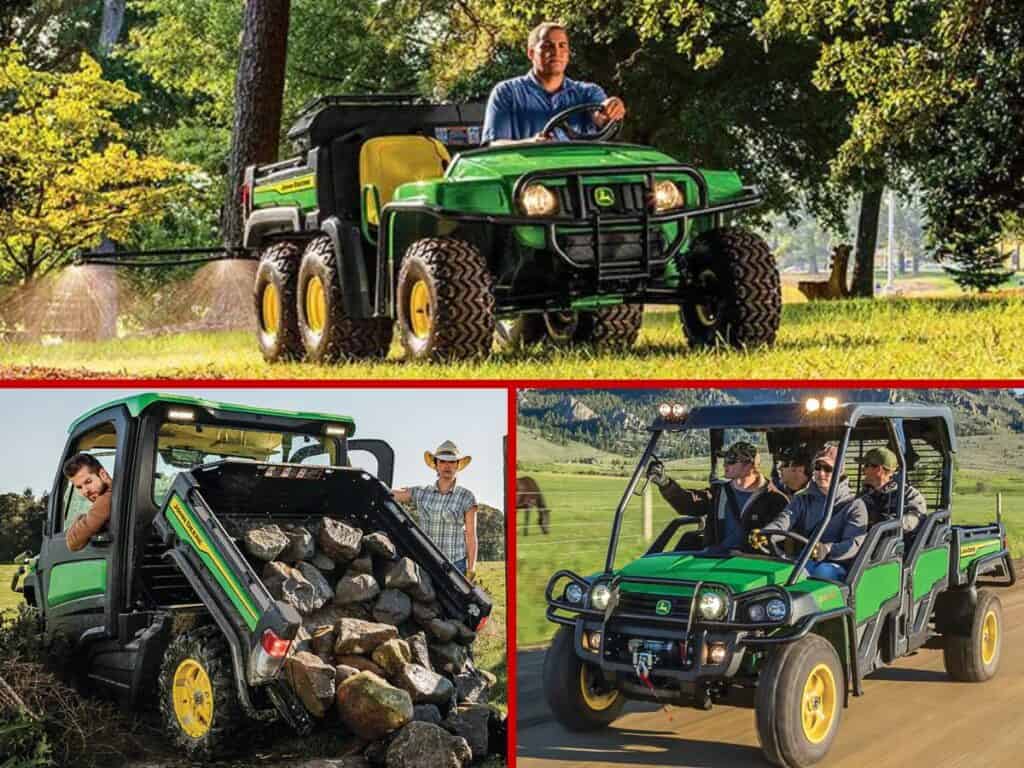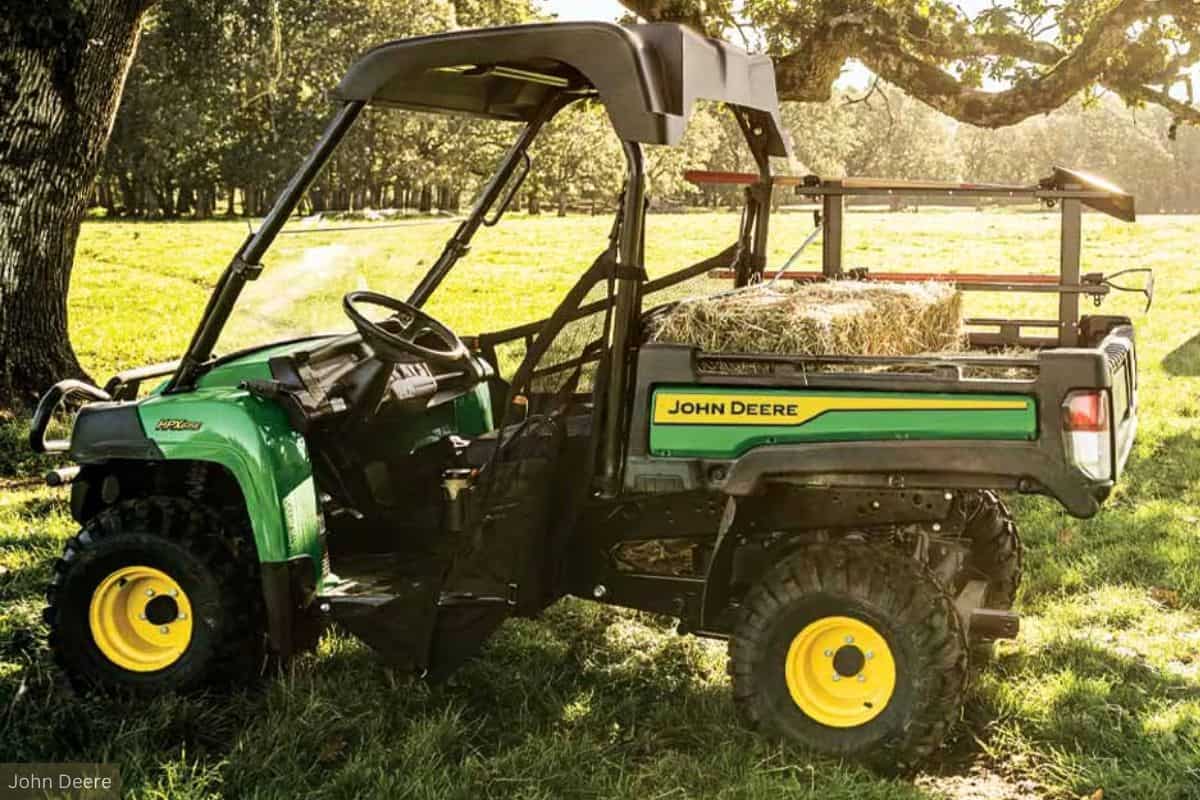Are you thinking about buying a Gator UTV?
If so, you need to read this post, as we answer 10 common questions about the John Deere Gator, providing you with all the information you need to make an informed decision before buying.
From pricing and weight to speed and engine specs, we’ll cover everything you need to know about these impressive machines.
So, whether you’re in the market for a new UTV or simply curious about what makes Gator UTVs stand out from the competition, keep reading.
Who Makes the Gator UTV?
Gator UTVs are made by John Deere, a renowned American equipment manufacturer with a rich history in the agriculture, forestry, and construction industries.
Founded in 1837 by blacksmith John Deere, the company initially focused on producing high-quality plows and other agricultural equipment.
Over time, John Deere expanded its product line to include a wide range of machinery and vehicles, including the popular Gator UTV.
John Deere introduced the Gator utility vehicle in 1992, designed to cater to the needs of farmers, ranchers, and outdoor enthusiasts.
Today, the John Deere Gator lineup has expanded to over 20 different models spread across four main series, including The Work Series, The Electric Work Vehicle, The Mid-size Crossover XUV, and The Full-size Crossover XUV.
The company’s commitment to reliability and customer satisfaction has helped establish the Gator UTV as a leader in the utility vehicle market, ranking right up there with popular UTV brands like Polaris and Honda and other equipment brands like Bobcat and Kubota.
Plus, the company’s extensive dealer network and customer support services further enhance the ownership experience, providing Gator UTV owners with access to expert advice, maintenance, and repairs when needed.
How Much Do Gators Cost?
When it comes to Gator UTV cost, pricing can vary substantially depending on the series, model, and features you choose.
In general, though, Gator UTVs start at $11,000 for an entry-level Work Series model and top out at over $40,000 for a top-of-the-line Full-Size Crossover XUV model.
If you’re curious how much a particular Gator side-by-side costs though, we’ve broken down the pricing for each series and model below, to give you a better idea of how much you can expect to pay based on the Gator.
Work Series Pricing: ($10,949 – $16,599+)
| Model | Starting Price |
|---|---|
| HPX615E | $14,899 |
| HPX815E | $16,599 |
| TH 6×4 DIESEL | $16,299 |
| TH 6×4 Gas | $13,299 |
| TX 4×2 | $10,949 |
Electric Work Vehicle Pricing: ($15,499+)
| Model | Starting Price |
|---|---|
| TE 4×2 ELECTRIC | $15,499 |
Mid-Size Crossover XUV Pricing: ($12,999 – $17,999+)
| Model | Starting Price |
|---|---|
| XUV560E | $12,999 |
| XUV590M | $15,999 |
| XUV560E S4 | $14,999 |
| XUV590M S4 | $17,999 |
Full-Size Crossover XUV Pricing: ($17,849 – $35,449+)
| Model | Starting Price |
|---|---|
| XUV835E | $17,849 |
| XUV835M | $20,249 |
| XUV835R | $33,749 |
| XUV865M Diesel | $21,949 |
| XUV865R | $35,449 |
| XUV825M S4 | $20,699 |
| XUV855M S4 | $22,399 |
Keep in mind that these costs are only starting prices and can vary based on location, authorized dealer, and any additional accessories or attachments you add.
Because of this, you should contact your local John Deere dealer or visit John Deere’s website directly to find the exact price of the particular Gator UTV model you’re interested in.
How Much Does the John Deere Gator Weigh?
The weight of a John Deere Gator UTV like its price varies based on the model and configuration.
On average, though, the John Deere Gator weighs between 1,100 and 2,500 pounds.
Always consult your Gator UTV’s owner’s manual for the most accurate weight information.
What is the Life Expectancy of a John Deere Gator?

The life expectancy of a John Deere Gator side-by-side depends on several factors, including maintenance, usage, and storage conditions.
On average though, a well-maintained John Deere Gator can last between 5,000 and 6,000 hours or between 10,000 and 12,000 miles before needing major repairs.
This translates to approximately 10+ years of life expectancy for the average user, which is slightly longer than the average side-by-side lifespan, which averages between 5 and 10 years.
It’s not uncommon, however, for Gator UTVs to do even better than 10+ years of life, as some Gator side-by-side owners have been using the same Gator for as much as 20 years without having to perform any major repairs.
To maximize the life expectancy of your John Deere Gator and to get everything out of the machine you can, it’s important to follow the manufacturer’s recommended maintenance schedule, which includes regular oil changes, filter replacements, and lubrication of key components.
In addition, promptly addressing any issues or wear and tear can also help extend the life of your Gator, preventing minor problems from escalating into more serious and costly repairs.
Proper storage is another key factor that plays a big role in a Gator UTV’s longevity, as Gators stored in a dry, covered area tend to last substantially longer than those stored outside in the elements.
If possible, use a breathable cover to prevent moisture buildup and rust formation like this one on Amazon.
In addition, it’s also a good idea to use a battery maintainer or trickle charger like this popular one on Amazon to keep the battery in good condition during extended periods of inactivity.
How Fast Does a Gator UTV Go?
The top speed of a John Deere Gator ranges from 15 to 45+ mph, depending on the model and its configuration, with the average top speed being around 25 mph.
To get an even better idea of how fast a Gator UTV goes though, we’ve broken down the speed ratings for three of the Gator lineups below.
John Deere Gator top speeds by series:
- The Work Series: 15 – 25 MPH
- The Mid-Size Crossover XUVs: 28 – 45+ MPH
- The Full-Size Crossover XUVs: 45+ MPH
While not necessarily known for their top speed or high-end performance, their speed is on par with other utility-based UTVs.
Designed primarily to provide a balance of power, efficiency, and safety. Gators are built to provide ample power and speed for most tasks and applications with a focus on stability and maneuverability.
Because of this, they’re popular across a wide range of users and use cases.
What is the Best Gator to Buy?

Whether you need a lightweight, budget-friendly option for basic tasks or a more powerful, versatile machine for tackling tougher jobs, determining the best Gator UTV to buy depends on your specific needs, budget, and intended use.
As each Gator model offers unique features and capabilities designed to cater to different applications and users.
So to help you decide which Gator side-by-side might be best for you let’s compare the different Gator lineups.
Work Series
If you’re looking for an affordable, reliable utility vehicle for light-duty tasks around your property, the Gator Work Series models are a great choice. With their durable construction and efficient engines, they’re perfect for hauling small loads and navigating tight spaces.
Available in five different models, not including the TE 4×2 Electric, which is often included in the Work Series lineup (more on this model next), the Work Series offers a range of options to suit your specific needs and budget.
These models feature sturdy, steel frames and rust-resistant dump bed polyethylene cargo boxes that can hold up to several hundred pounds of gear or materials.
The cargo capacity varies between models, but all offer ample space for hauling tools, supplies, or landscaping materials. The tailgates can be opened or removed for easy loading and unloading.
Powered by efficient gas or diesel engines, the Gator Work Series models provide reliable performance and good fuel economy. Plus, their variable speed drives ensure smooth acceleration and responsive handling.
Overall, the John Deere Gator Work Series is an excellent choice for homeowners, farmers, or anyone who needs a dependable, versatile utility vehicle for everyday tasks.
Electric Work Vehicle
For those who want an eco-friendly and quiet UTV, the John Deere Gator Electric Work Vehicle is a great choice.
The TE 4×2 Electric model provides reliable, efficient performance for light-duty tasks while minimizing environmental impact and noise pollution.
A durable, 48-volt electrical system powers the Electric Work Vehicle, delivering clean, quiet power without the need for gas or oil.
The advanced battery technology offers ample runtime for most everyday tasks, and you can easily recharge the vehicle using a standard 110-volt outlet.
Plus, the Electric Work Vehicle offers the same durability and versatility as its gas-powered counterparts.
Mid-Size Crossover XUVs
If you’re looking for a versatile utility vehicle that can handle both work and recreational tasks, the Gator Mid-Size Crossover XUV lineup is an excellent choice. These models offer a perfect balance of power, performance, and comfort, making them well-suited for a range of applications.
The Mid-Size Crossover XUVs are designed to tackle tougher terrain and more demanding jobs than their Work Series counterparts.
These models typically feature more powerful engines, advanced suspension systems, and higher ground clearance, allowing them to navigate rough or uneven terrain. They also offer increased towing and hauling capacities, making them ideal for transporting heavy loads or equipment.
With their advanced features, durable construction, and versatile performance, the Mid-Size Crossover XUVs are well-equipped to tackle just about any task or adventure.
Full-Size Crossover XUVs
For those who require the ultimate in power, performance, and versatility, the Gator Full-Size Crossover XUV lineup is the perfect choice. These models are designed to tackle the toughest jobs and the most challenging terrain, offering uncompromising capability and comfort for a wide range of applications.
The Full-Size Crossover XUVs are built with heavy-duty, high-strength steel frames and advanced suspension systems that provide exceptional durability and ride quality.
These models feature higher ground clearance, larger tires, and more powerful engines than their Mid-Size counterparts, allowing them to navigate even the most rugged terrain.
They also offer increased towing and hauling capacities, making them ideal for transporting heavy equipment, materials, or recreational gear.
What Competes With a John Deere Gator?

The John Deere Gator faces competition from many other well-known brands in the industry.
These competitors like John Deere offer a range of models with varying features, capabilities, and price points.
Some of the main competitors to the John Deere Gator include:
- Polaris: Polaris is a well-established brand in the off-road vehicle market, offering a wide range of UTVs, including the popular Ranger and RZR series.
- Can-Am: Can-Am designs and produces a range of UTVs under the Defender series for both work and play.
- Honda: Honda designs a line of UTVs called the Pioneer series for a variety of applications, from farming and hunting to trail riding and adventure touring.
- Kubota: Kubota offers a line of rugged, reliable UTVs called the RTV series. Kubota designs these vehicles for heavy-duty work applications, equipping them with powerful diesel engines, hydrostatic transmissions, and hydraulic bed lifts.
- Kawasaki: Kawasaki designs and produces a range of UTVs under the Mule series for both work and recreational applications. Kawasaki Mule UTVs offer a combination of power, comfort, and versatility.
- Yamaha: Yamaha designs a lineup of UTVs called the Viking and Wolverine series for work, hunting, and recreational applications.
While these competitors offer a range of capable and reliable UTVs, the John Deere Gator lineup remains a top choice for many powersports riders due to its combination of durability, performance, and versatility.
The Gator’s reputation for quality, backed by John Deere’s extensive dealer network and customer support, sets it apart from the competition and ensures that owners can rely on their vehicles for years to come.
To see a full list of competitors to the John Deere Gator, check out our blog post “Complete List of Side-By-Side Brands (26 Manufacturers)“.
Where is the John Deere Gator Built?
The majority of John Deere Gator utility vehicles are manufactured in Horicon, Wisconsin, at a state-of-the-art 388,000-square-foot facility.
This primary manufacturing site is responsible for producing a wide range of Gator models, including the Work Series, Mid-Size Crossover XUVs, and Full-Size Crossover XUVs.
In addition to the Horicon Works facility, John Deere also utilizes several other factories in the Gator production process, including facilities located in Augusta Georgia, Waterloo, Iowa, and Greenville, Tennessee.
Does John Deere Make an Electric Gator?
John Deere does offer an electric Gator as part of its Work Series lineup called the TE 4×2 Electric, which is a quiet, eco-friendly alternative to traditional gas-powered UTVs.
A 48-volt electrical system with eight Trojan® T-105 batteries producing 12 KWh powers the Gator TE 4×2 Electric.
This system provides ample power for tackling a variety of light-duty tasks, such as transporting, hauling, and towing.
The electric motor delivers instant torque, providing smooth and responsive acceleration.
One of the key advantages of the Gator TE 4×2 Electric is its quiet operation. With no gas engine noise or exhaust emissions, this UTV can be used in a variety of settings where noise and air pollution are a concern, such as parks, golf courses, and residential areas.
The electric powertrain also requires less maintenance than a traditional gas engine, reducing overall operating costs.
While the Gator TE 4×2 Electric may not have the same range, payload, or towing capacity as gas-powered alternatives, it still offers plenty of capability for a wide range of light-duty applications.
To learn more about the only electric Gator, check out John Deere’s website here.
How Much Weight Can a Gator Carry & Tow?
John Deere designs its Gator utility vehicles to offer ample weight capacity for a wide range of applications, from hauling tools and supplies on a job site to transporting heavy loads of dirt, gravel, or feed on a farm.
The weight capacity and towing capacity of a John Deere Gator utility vehicle, however, does vary depending on the series and specific model.
John Deere designs each Gator model to carry a specific amount of weight in its cargo box and overall, as well as tow a certain amount of weight behind the vehicle, referred to as max cargo capacity, payload capacity, and towing capacity.
Understanding these weights is crucial for ensuring safe operation and preventing damage to the vehicle.
Here is a breakdown of the weight capacities for the different John Deere Gator series based on its model’s capacities:
Work Series Weight Capacities:
- Cargo Capacity: 500 – 1,200 Pounds
- Payload Capacity: 900 – 1,400 Pounds
- Towing Capacity: 500 – 1,400 Pounds
Mid-Size Crossover XUV Weight Capacities:
- Cargo Capacity: 500 Pounds
- Payload Capacity: 900 – 1,300 Pounds
- Towing Capacity: 1,500 Pounds
Full-Size Crossover XUVs Weight Capacities:
- Cargo Capacity: 1,000 Pounds
- Payload Capacity: 1,297 – 1,508 Pounds
- Towing Capacity: 1,500 – 4,000 Pounds
To ensure safe operation, always refer to your specific Gator model’s owner’s manual for the exact cargo box, payload, and towing capacities, as these capacities can vary somewhat depending on the production year.
To see how much other UTVs can tow, check out our blog post “Average UTV Towing Capacity (19 Popular Models Compared)“.
Recent Posts
Is Can-Am Better Than Polaris? This question has been debated for years, sparking intense debates in off-road communities and showrooms. As two titans in the world of ATVs and UTVs, Can-Am and...
Whether you're an adult looking for a new adventure or introducing your kids to the sport, finding the best beginner dirt bike is crucial to kick-start your off-road journey on the right...

